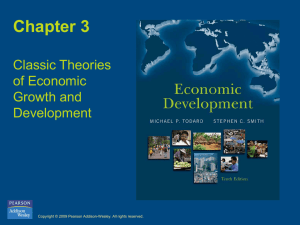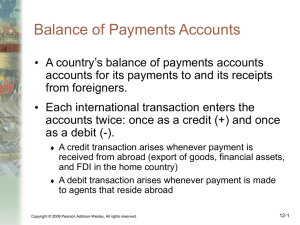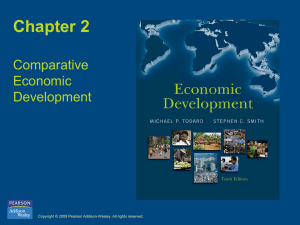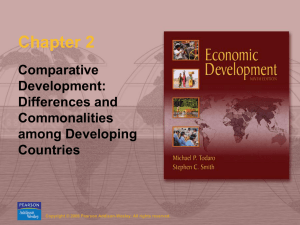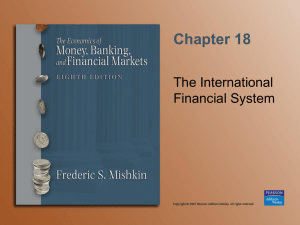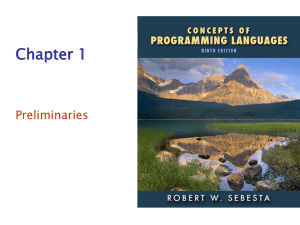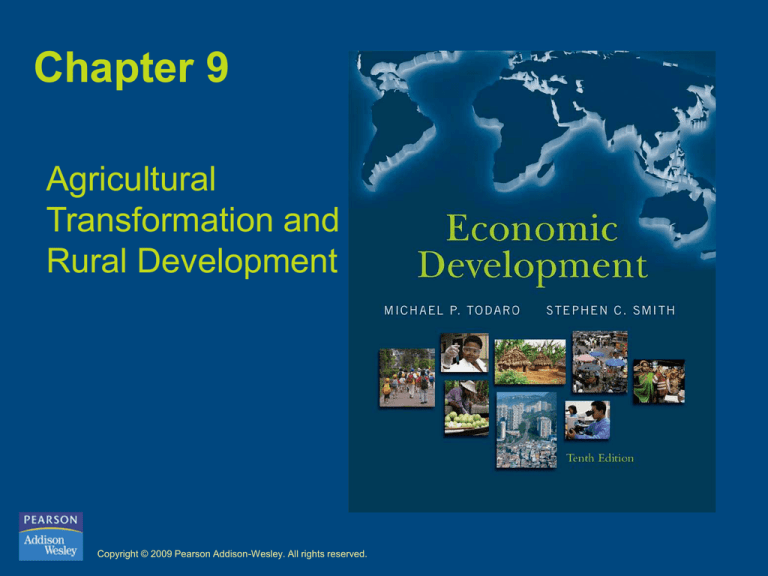
Chapter 9
Agricultural
Transformation and
Rural Development
Copyright © 2009 Pearson Addison-Wesley. All rights reserved.
The Imperative of Agricultural
Progress and Rural Development
• The heavy emphasis in the past on rapid
industrialization may have been misplaced
• Agricultural development is now seen as an
important part of any development strategy
• Three complementary elements of an agriculture –
and employment-based strategy
– Accelerated output growth
– Rising domestic demand for agricultural output
– Non-agricultural rural labor intensive rural development
activities that are supported by the farming community
Copyright © 2009 Pearson Addison-Wesley. All rights reserved.
9-2
Agricultural Growth: Past
Progress and Current Challenges
• Although agriculture employs the majority of
the LDC labor force, it accounts for a much
lower share of total output
• Agricultural production is rising but unevenly
Copyright © 2009 Pearson Addison-Wesley. All rights reserved.
9-3
Figure 9.1 As Countries Develop, the Shares
of GDP and Labor in Agriculture Tend to
Decline, but with Many Idiosyncrasies
Copyright © 2009 Pearson Addison-Wesley. All rights reserved.
9-4
Figure 9.2 Cereal Yields by World
Region, 1960-2005
Copyright © 2009 Pearson Addison-Wesley. All rights reserved.
9-5
Agricultural Growth: Past
Progress and Current Challenges
• Africa- malnutrition and famine inspire calls
for a green revolution.
• Typically, governments do not prioritize
agriculture and emphasize industrialization
• Focus on governmental and NGO initiatives
in poverty alleviation and agricultural reform
Copyright © 2009 Pearson Addison-Wesley. All rights reserved.
9-6
Agricultural Growth: Past
Progress and Current Challenges
• The structure of Agrarian Systems in the
Developing World. Three types of countries.
– Agriculture based countries
– Transforming countries
– Urbanized countries
Copyright © 2009 Pearson Addison-Wesley. All rights reserved.
9-7
Figure 9.3 Agriculture’s Contribution to
Growth and the Rural Share in Poverty
in Three Types of Countries
Copyright © 2009 Pearson Addison-Wesley. All rights reserved.
9-8
Table 9.1 Land Productivity in
Developed and Developing Countries
Copyright © 2009 Pearson Addison-Wesley. All rights reserved.
9-9
Agricultural Growth: Past
Progress and Current Challenges
• Peasant Agriculture in Latin America, Asia, and
Africa
– Latin America and Asia: similarities and differences
– The Latifundio–Minifundio dualistic pattern in Latin
America
– The fragmented and heavily congested dwarf land
holdings in Asia
– Africa: extensive cultivation patterns
Copyright © 2009 Pearson Addison-Wesley. All rights reserved.
9-10
Table 9.2 Distribution of Farms and Farmland by
Operational Farm Size and Land Tenure Status In
Selected Developing Countries in Asia and Latin
America
Copyright © 2009 Pearson Addison-Wesley. All rights reserved.
9-11
Table 9.3 Changes in Farm Size and Land
Distribution
Copyright © 2009 Pearson Addison-Wesley. All rights reserved.
9-12
Agricultural Growth: Past
Progress and Current Challenges
• Agrarian Patterns in Latin America: Progress and
Remaining Poverty Challenges
– Apart from latifundios (large holdings) and minifundios
(small farms) production occurs on family farms and
medium sized farms.
– Latifundios are relatively inefficient as landlords are not
interested in farming and large farms typically entail
higher transaction costs
– Overall the sector seems to be doing well. Chile
(diversification), and Brazil (biofuels)
– Extreme inequalities still persist.
Copyright © 2009 Pearson Addison-Wesley. All rights reserved.
9-13
Agricultural Growth: Past
Progress and Current Challenges
• Transforming Economies: Problems of
Fragmentation and Subdivision of Peasant Land in
Asia
– Impact of colonial rule in strengthening land tenure
systems of private property rights and the consequent
rise of moneylenders
– Contemporary landlordism in India and Pakistan
involves absentee landlordism and persistence of
sharecroppers and tenant farmers
– Rapid population growth resulted in more fragmentation
and peasant impoverishment
Copyright © 2009 Pearson Addison-Wesley. All rights reserved.
9-14
Agricultural Growth: Past
Progress and Current Challenges
• Subsistence Agriculture and Extensive
Cultivation in Africa
– Low productivity due to lack of technology
– Shifting Cultivation
– Seasonal demand for labor depending upon the
rainy season
– High dependence on unimproved seeds sown
on unfertilized, rain-fed fields.
Copyright © 2009 Pearson Addison-Wesley. All rights reserved.
9-15
Figure 9.4 Expansion of Modern Inputs
in the World’s Developing Regions
Copyright © 2009 Pearson Addison-Wesley. All rights reserved.
9-16
The Important Role of Women
• Women provide 60% to 80% of agricultural
labor in Africa and Asia, and 40% in Latin
America
• Women work longer hours than men
• Government assistance programs tend to
reach men, not women
Copyright © 2009 Pearson Addison-Wesley. All rights reserved.
9-17
The Economics of Agricultural
Development: Transition From Peasant
to Commercial Farming
• Subsistence farming: risk aversion, uncertainty, and
survival
– Traditional two-factor neoclassical model is not adequate
– Price uncertainty and limited access to credit and insurance
explains risk aversion
– Risk averse subsistence farmers prefer technologies that combine
low mean-per-hectare with low variance to alternative high yielding
technologies
– Efforts to minimize risk and remove commercial and institutional
obstacles to small farmer innovation are necessary
Copyright © 2009 Pearson Addison-Wesley. All rights reserved.
9-18
Figure 9.5 Small-Farmer Attitudes toward
Risk: Why It Is Sometimes Rational to Resist
Innovation and Change
Copyright © 2009 Pearson Addison-Wesley. All rights reserved.
9-19
Figure 9.6 Crop Yield Probability
Densities of Two Different Farming
Techniques
Copyright © 2009 Pearson Addison-Wesley. All rights reserved.
9-20
Figure 9.7 Incentives under
Sharecropping
Copyright © 2009 Pearson Addison-Wesley. All rights reserved.
9-21
The Economics of Agricultural
Development: Transition From Peasant
to Commercial Farming
• Sharecropping and interlocking factor markets
– Intrinsically Inefficient due to poor incentives (Marshall)
– Monitoring approach (Cheung)
– Giving sharecroppers a larger share of the produce and
security of tenure on land can increase efficiency
– Interlocking factor markets in sharecropping act against
peasant interests
Copyright © 2009 Pearson Addison-Wesley. All rights reserved.
9-22
The Economics of Agricultural
Development: Transition From Peasant
to Commercial Farming
• The transition to mixed and diversified
farming
• From divergence to specialization: modern
commercial farming
Copyright © 2009 Pearson Addison-Wesley. All rights reserved.
9-23
Toward a Strategy of Agricultural
and Rural Development
• Improving small-scale agriculture
– Institutional and pricing policies: Providing necessary
economic incentives
– Adapting to New opportunities and New Constraints
• Conditions for Rural development
– Land Reform
– Supportive polices
– Integrated Development Objectives
Copyright © 2009 Pearson Addison-Wesley. All rights reserved.
9-24
Case Study: Kenya
Copyright © 2009 Pearson Addison-Wesley. All rights reserved.
9-25
Concepts for Review
• Agrarian systems
• Cash crops
• Interlocking factor
markets
• Diversified farming
• Landlord
• Family farm
• Land reform
• Green revolution
• Latifundio
• Integrated rural
development
• Medium-sized farms
• Minifundio
• Mixed farming
Copyright © 2009 Pearson Addison-Wesley. All rights reserved.
9-26
Concepts for Review (cont’d)
• Moneylender
• Scale-neutral
• Patrón
• Sharecropper
• Per capita agricultural
production
• Shifting cultivation
• Per capita food
production
• Staple foods
• Price bands
• Productivity gap
Copyright © 2009 Pearson Addison-Wesley. All rights reserved.
• Specialized farming
• Subsistence farming
• Tenant farmer
• Transactions costs
9-27







